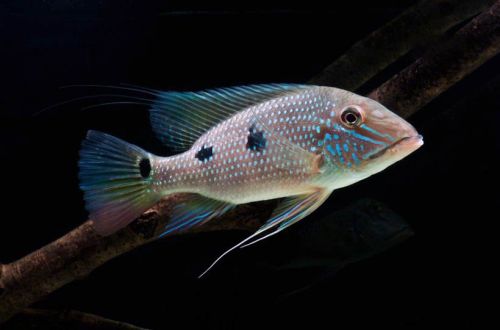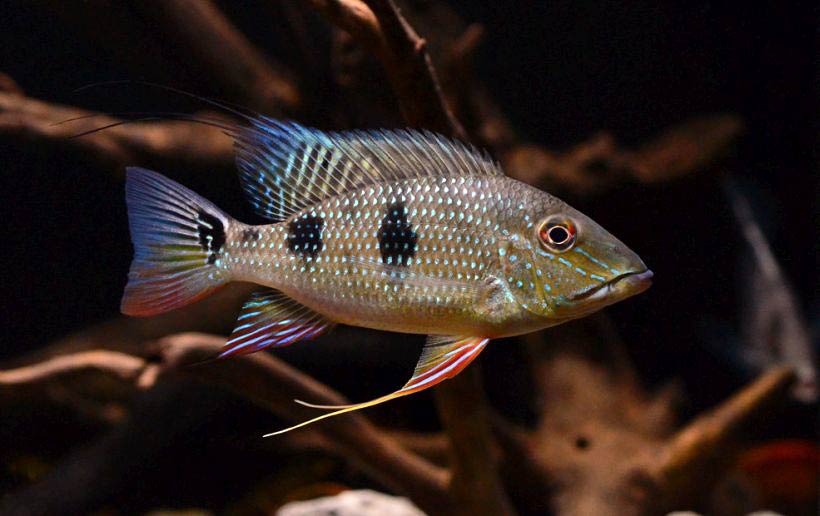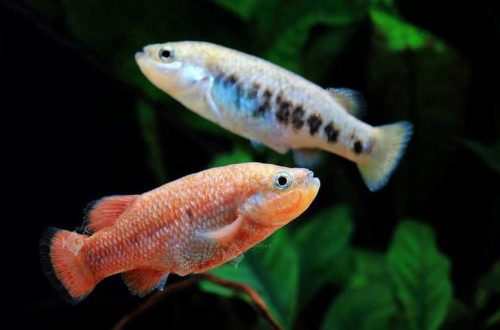
Geophagous demon
Geophagus demon or Satanoperka Demon, scientific name Satanoperca daemon, belongs to the Cichlidae family. Although this fish has such a threatening name, in reality it is quite peaceful and will not threaten other tankmates, even if they are much smaller than it. Although there are no compatibility problems, its maintenance will cause a lot of trouble due to the peculiarities of the diet and the high requirements for water quality.

Contents
Habitat
It comes from South America from the Rio Negro basin (Amazonas, Brazil), as well as from the upper reaches of the Orinoco River from Colombia and Venezuela. The natural habitat is characterized by meandering rivers with a calm current, flowing through tropical forests. The channel is sandy-silty with a thick layer of fallen leaves and numerous snags. The water contains a large amount of substances of organic origin, giving it a rich brown hue. Darkness reigns below the surface.
Brief information:
- The volume of the aquarium – from 500 liters.
- Temperature – 24-28°C
- Value pH — 3.5–6.0
- Water hardness – 1–5 dGH
- Substrate type – sandy
- Lighting – subdued
- Brackish water – no
- Water movement is weak
- The size of the fish is up to 25 cm.
- Food – small sinking food from a variety of products
- Temperament – peaceful
- Keeping in a group of 5-8 individuals
Description

Adults reach a length of 20–25 cm. The color is gray with numerous blue specks throughout the body and fins. The ventral and anal fins, as well as the lower edge of the tail, are reddish. A characteristic feature are three large black spots on the side. Sexual dimorphism is weakly expressed, males and females are practically indistinguishable from each other.
Food
In nature, they feed near the bottom, taking sand / silt into their mouths and sifting it through their gills, filtering out zoo- and phytoplankton. In a home aquarium, small sinking products should be used, for example, a mixture of dry flakes, granules rich in herbal supplements, with pieces of frozen or fresh bloodworm, shrimp meat, shellfish, artemia. The diet may contain other plant-based foods, such as small pieces of vegetables and fruits that are native to South America.
Maintenance and care, arrangement of the aquarium
Recommended aquarium sizes for a group of 5-6 fish start at 500 liters. The design is simple and completely determined by the nutritional habits of the Geophagus demon. There are only two decor elements – sandy soil and a few snags. The lighting is subdued. There is no need for aquatic plants. The substrate should not contain stones that can get stuck in the mouth of the fish during feeding.
Water quality is of paramount importance for long-term maintenance. Fish are extremely sensitive to the slightest changes in hydrochemical values and the accumulation of products of the nitrogen cycle. In addition, the water must contain dissolved tannins. Usually dry leaves of some trees are used for this purpose. However, in this case, this is not applicable, since the remains of the leaves will clog the soil. The solution is seen in the introduction of essences containing tannins (one of the tannins) in water treatment, which can be found in pet stores in the form of small bottles or ordered via the Internet.
The filtration system plays a key role in maintaining a healthy ecosystem. Saving on it will not be appropriate. It is worth considering that during feeding, the fish create a cloud of sand suspension, and if it constantly gets into the filter, this will at best lead to a decrease in power, and at worst to a breakdown. Therefore, when choosing a particular filter model, you should consult with a specialist and take into account all the nuances.
Maintenance of the aquarium will require a weekly replacement of part of the water (50–70% of the volume) with fresh water and regular removal of uneaten food residues and excrement.
Behavior and Compatibility
The name of this species does not at all reflect the peculiarities of its behavior. Geophagus demon is a completely peaceful and calm fish, able to get along with other non-aggressive species. It does not pose a danger to small neighbors in the aquarium. Prefers to be in a group of 5-6 individuals. The need to be in a pack is especially strong in young individuals.
Breeding / breeding
This species is reluctant to breed in the artificial environment of home aquaria. Successful spawnings have been recorded in specialized fish farms and in very large professional aquarium setups.
With the onset of the mating season, the male and female form a pair and retire, choosing a suitable place for spawning. Together they build something like a nest – this is a large hole at the bottom with a diameter of 1-2 meters. It becomes their territory, which the couple will protect from the encroachments of other fish. After some time, the female lays the first portion of eggs, and the male immediately fertilizes them. This continues until about 200 eggs are laid. The masonry is covered with a layer of leaves on top. The female stays in close proximity to the eggs to protect them. The male, in turn, patrols the vicinity of the territory.
The incubation period lasts about 3 days. Two days later, the fry begin to swim freely. The fish continue to guard their offspring until they are large enough.
Fish diseases
The main cause of diseases lies in the conditions of detention, if they go beyond the permissible range, then immunity suppression inevitably occurs and the fish becomes susceptible to various infections that are inevitably present in the environment. If the first suspicions arise that the fish is sick, the first step is to check the water parameters and the presence of dangerous concentrations of nitrogen cycle products. Restoration of normal/suitable conditions often promotes healing. However, in some cases, medical treatment is indispensable. Read more about symptoms and treatments in the Aquarium Fish Diseases section.





